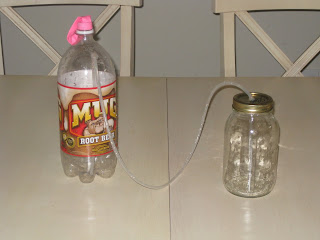So, Stephanie complains that I am too persistant. That I can't move on until I've done what I wanted. If you've read her blog, you can see where Lauren gets it. I got my balloon to float. I was super excited when I let it go. I had butterflies in my stomach becuase I had an audience, but it worked, it floated.

Above is the simple cheap filtration system I made. It consists of a quart jar with a tube hot glued in a hole in the lid, a pop bottle filled with water that the tube goes in from the top but extends to the bottom, and a balloon. So the acid/aluminum reaction of last post takes place in the jar and the hydrogen + impurities such as acid vapor go through the tube into the pop bottle where it bubbles through. The hydrogen gas makes it into the balloon, but the acid vapor is cooled and held in solution.
Above is my crew/audience. Some boys, friends of ours, came over to swim and eat dinner. Lauren although not evident from the picture is in love with the boy in the grey shirt. Also pictrued is a red balloon which happens to be floating because it happens to contain a gas lighter than air.
NERD MOMENT:
This may actually be a double nerd moment about the double meaning of chemistry. So one meaning is what I am doing on my blog. How compounds react with their environment. The other is one of love.
First we learn about gravity. Every object with mass exibits some force of attraction to matter around it. Even tiny little particles.
Second we learn that opposits attract. (+) and (-) charges have a force of attraction. Further more we learn from hydrogen bonding that it doesn't take a full neg and a full pos but even partial charges are attractive and strong enough to go against the force of gravity as in water ascending the trunk of a tree.
Third we learn about vanderwalls interactions that are like atoms, similar to number one, want to pack close together and can weakly hold themselves in position.
Fouth Hydrophobic interactions. Things insouble in water, they don't dissolve, pack as tightly as the can to minimize disorder or entropy in the universe. We happen to be surrounded by water in the atmosphere. I know many of you say this is a stretch, but in chemistry, especially physical chemistry the atmosphere is considered a liquid. Last I checked we don't dissolve in water, so what do we take from all of this?
A simple chemical reaction:
one boy + one girl --> two hearts beating wildly
A balance equation gives
Jeff + Stephanie --> Eternal Love
Here are the rest of the words to the song that is one of Stephanie and my favorites. One boy, one girl by Collin Raye:
He finally gave in to his friend's girlfriend when she said "there's someone you should meet" At a crowded restaurant way cross town, he waited impatiently When she walked in, their eyes met, And they both stared Right there and then, Everyone else disappeared, but
Chorus: One boy, one girl, Two hearts beating wildly, To put it mildly, it was love at first sight. He smiled, she smiled, and they knew right away This was the day they'd been waiting for all their lives. For a moment the whole world Revolved around one boy, and one girl
In no time at all, they were standing there in the front of a little church Among their friends and family, repeating those sacred words. The preacher said "son, kiss your bride" And he raised her veil Like the night they met, Time just stood still, for
Chorus: One boy, one girl Two hearts beating wildly To put it mildly, it was love at first sight. He smiled, she smiled, and they knew right away This was the day they'd been waiting for all their lives, And for a moment the whole world, Revolved around one boy, and one girl
He was holding her hand when the doctor looked up and grinned, "Congratulations, twins"
Chorus: One boy, one girl Two hearts beating wildly To put it mildly, it was love at first sight. He smiled, she smiled, and they knew right away This was the day they'd been waiting for all their lives, And for a moment the whole world, Revolved around one boy, and one girl
Happy 3 year Anniversary












